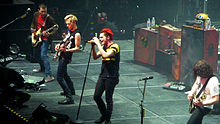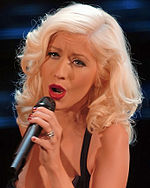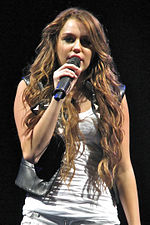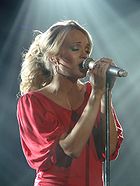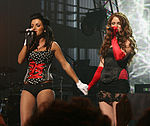- 2000s in music
-
For music from a year in the 2000s, go to 00 | 01 | 02 | 03 | 04 | 05 | 06 | 07 | 08 | 09
Popular music Timeline of musical events 2010s • 2000s • 1990s • 1980s • 1970s • 1960s • 1950s • 1940s • 1930s • 1920s • 1910s • 1900s • 1890s • 1880s • 1870s • 1860s • 1850s • 1840s • 1830s • 1820s • 1810s • 1800s • 1790s • 1780s • 1770s • 1760s • 1750s • 1740s • 1730s • 1720s • 1710s • 1700s • 1690s • 1680s • 1670s • 1660s • 1650s • 1640s • 1630s • 1620s • 1610s • 1600s • 1590s • 1580s • 1570s • 1560s • 1550s • 1540s • 1530s • 1520s • 1510s • 1500s • Early history List of popular music genres This article includes an overview of the major events and trends in popular music in the 2000s.
In North America, Europe and Oceania, pop and dance music subgenres, such as dance-pop, teen pop and bubblegum pop, have remained popular throughout or in parts of the decade. Similarly to the 1990s, hip hop and contemporary R&B also remained highly popular genres throughout the decade. Despite the hip hop dominance which lasted for most of the decade, rock music was still popular, notably alternative rock, especially genres such as Post-grunge, pop punk, emo, and indie rock; the decade also saw the garage rock and post punk revival. Despite a slight slip of popularity in the early part of the decade, adult contemporary and country music were still able to find success throughout the 2000s. Electronic music was also highly popular throughout the decade; at the beginning of the 2000s, genres such as trance, chillout, house, indietronica,[1] and Eurodance (in Europe) were popular, yet, by the latter end of the decade, dance-oriented forms of electronic music, such as synthpop, electropop, Nu-disco and electro house had become popular. By the end of the decade, a fusion between hip hop and electronic dance which had originated in the 80s, known as electro hop, also became highly popular.
In Asia and Far Eastern musical markets, with the advent of globalisation, music has become increasingly Westernised, with influences of pop, hip hop and contemporary R&B becoming ever–present in Eastern markets. American and European popular music have become increasingly popular in Asia. In the Far East, genres such as J-Pop and K-Pop remained popular throughout the decade; influences of R&B, techno, hip hop and bubblegum pop music persisted throughout the decade. In other parts of Asia, including India, Indian pop music, closely linked to Bollywood films and filmi music, still remained popular, even though Western pop music has also had success.
In Latin America, Latin pop music remained popular throughout the decade. Whilst R&B, hip hop and pop rock did have influence and success in Latin America, Latin-based pop music remained highly popular. Reggaeton became a definitive genre in 2000s Latin music, as well as salsa and merengue. Subgenres fusing Latin music such as merengue and reggaeton with hip hop and rap music became popular from the mid-part of the decade onwards.
Contents
The U.S. and North America
Main article: Music history of the United States in the 2000sHip hop
 Eminem is considered the biggest hip-hop act of the decade as well as the best-selling overall music artist.
Eminem is considered the biggest hip-hop act of the decade as well as the best-selling overall music artist.
Hip hop dominated popular music in the 2000s. Artists such as Eminem, 50 Cent, OutKast, The Black Eyed Peas, T.I., Kanye West, Nelly, Nas, Jay-Z, Missy Elliott, Lil Wayne, The Game and Ludacris were among the dominant mainstream hip hop artists to have represented the Hip hop genre for the decade. Distinct regional differences also developed outside of the hip hop/rap strongholds of the 1990s, New York City and Los Angeles.[2] Gangsta rap wanes by the early 2000s, as more commercially oriented party rap dominates the charts.[3] The emergence of hip-hop from the south and the midwest was starting to take place, and by the end of the decade, hip-hop was starting to spread internationally.
During the 2000s Eminem, who is perhaps best known for being one of the few successful white rappers in the music industry, enjoyed a massive commercial success and maintained commercial relevance by attempting to be controversial and subversive. According to Billboard, Eminem has two of his albums among the top five highest selling albums of the 2000s. After the release of his album, Relapse, Eminem became the best selling rapper of all time.[4]
Alternative hip hop, almost unknown in the mainstream, except for a few crossover acts, evolved throughout the decade with the help of artists such as Mos Def, The Roots, Atmosphere, Aesop Rock, and Common, who achieved unheard-of success for their field. Throughout the 2000s, Alternative Hip hop continued its philosophical, positive, and complex lyrical subject matter, while denouncing materialism, fashion, and money. This sub-genre also includes spoken word and a branch of slam poetry. The sub-genre could be said to be related to both the old school hip-hop culture of the 1980s and 1990s, and the indie rock and hipster subcultures.
By 1999, more 2000s styled glam started coming in, along with dirty south and crunk, with artists such as Mannie Fresh, Cam'ron, Lil Jon, Ja Rule, Ludacris, Three 6 Mafia, Ying Yang Twins, Neptunes, Timbaland and Jay-Z.[5]
Auto-Tune became popular by mid-2007, with hip-hop artist T-Pain starting the craze. AutoTune was popular in the earlier part of the decade as well, but it was used as an effect than a major replacement of the standard human voice. Artists such as Daft Punk, Eiffel 65, *NSYNC, 98 Degrees, Willa Ford, and even Faith Hill have used autotune in their songs. It was first known as the "Cher effect" since it was used in the song "Believe" by "Cher" in 1998. The Black Eyed Peas began utilizing auto-tune and electropop–dance in their most successful album to date, The E.N.D., which spawned five top ten hit singles: Boom Boom Pow, I Gotta Feeling, Meet Me Halfway, Imma Be, and Rock That Body.
Rock
Rock remained popular in the beginning of the decade, despite the increasing popularity of hip-hop, but experienced a diminished presence on mainstream music charts by the end of the decade.Although the rock genre is not as prominent in the Top 40 as in recent decades, it still maintains some popularity on rock only stations.[6][7][8] Modern rock as a radio format experienced a sharp decline, with high-profile cornerstone stations like WLIR-FM, K-Rock in New York City and WBCN in Boston flipping to other formats. New York City, once the leading market for the format, has only one modern rock station, 101.9 WRXP-FM.
Alternative rock and Indie rock
Post-grunge
 Nickelback has released seven number-one singles on the Mainstream Rock Tracks chart and has sold over 35 million records.
Nickelback has released seven number-one singles on the Mainstream Rock Tracks chart and has sold over 35 million records.
After the first wave of post-grunge bands lost their popularity near the end of the 90s, a more popularized form spawned bands like, Puddle of Mudd and Nickelback. The bands took post-grunge into the 21st century with considerable commercial success, abandoning most of the angst and anger of the original movement for more conventional anthems, narratives and romantic songs. They were followed in this vein by new acts including Shinedown, Seether and 3 Doors Down, who combined post-grunge with country music and Southern rock.[9]
In addition, some of the most successful Post-grunge bands in the 1990s, such as Foo Fighters and Creed, also continued their success during the 2000s.
Garage rock and post-punk revival
 The White Stripes were one of the most successful emerging American rock acts of the decade.
The White Stripes were one of the most successful emerging American rock acts of the decade.
In the early 2000s, a new group of bands emerged into the mainstream which drew primary inspiration from post-punk and new wave and were variously characterised as part of a garage rock, post-punk or new wave revival.[10][11][12][13] Because the bands came from across the globe, cited diverse influences (from traditional blues, through new wave to grunge), and adopted differing styles of dress, their unity as a genre has been disputed.[14] There had been attempts to revive garage rock and elements of punk in the 1980s and 1990s and by 2000 scenes had grown up in several countries.[15] The Detroit rock scene included The Von Bondies, Electric Six, The Dirtbombs and The Detroit Cobras[16] and that of New York which included Radio 4, Yeah Yeah Yeahs and The Rapture.[17] Social networking sites such as MySpace and Purevolume enabled amateur artist to promote their music, and thanks to the internet, many underground unsigned artists become discovered and listen to by alternative communities.
Two of the most successful bands from these scenes were The Strokes, who emerged from the New York club scene with their début album Is This It (2001) and The White Stripes, from Detroit, with their third album White Blood Cells (2001), as well as Interpol from New York, with their debut album Turn On the Bright Lights.[18] They were christened by the media as the "The" bands, and dubbed "The saviours of rock 'n' roll", leading to accusations of hype.[19]
Indie rock
During the mid 2000s, bands such as Modest Mouse and Arcade Fire released Indie rock albums that broke into the mainstream and gave Indie rock recognition. The late 2000s also saw more Indie Rock bands such as MGMT, LCD Soundsystem, Grizzly Bear, and Vampire Weekend gain popularity around the world, including the United States, thanks to the rise of independent internet music blogs. The rising popularity of Internet radio has led to high album sales, despite little or no radio play for Indie rock bands.
Hard rock and heavy metal
During the early 2000s, a new wave of metal began with interest in the newly emerging genre nu metal and genres of a similar style such as rap metal and the later mainstream success rap rock. The popularity of nu metal music carried over from the late 1990s, where it was introduced by early work from bands such as Korn, Deftones, Limp Bizkit, Slipknot and Coal Chamber, into the early 2000s with the similar genre, rap rock, bringing in a wave of monster-hit artists such as System of a Down, Evanescence, Staind, Papa Roach, and Disturbed. The success of Korn's third studio album, Follow The Leader, brought nu metal to the mainstream. Linkin Park's debut album Hybrid Theory, released in 2000, sold over 29 million copies worldwide. The band's next album Meteora is the most successful album on the Modern Rock Tracks chart. However, by 2002 and 2003, there were signs that nu metal's mainstream popularity was weakening.[9] Crazy Town's second album Darkhorse, Korn's long awaited fifth album Untouchables, Limp Bizkit's fourth album Results May Vary, Linkin Park's second album Meteora, Papa Roach's second album Lovehatetragedy, P.O.D.'s third major-label album Payable on Death and Static-X's third album Shadow Zone did not sell as well as their previous releases, mainly because those groups had changed their sound, while nu metal bands were played more infrequently on rock radio stations and MTV began focusing on pop punk and emo bands such as Good Charlotte and Fall Out Boy, respectively.[20] Since then, many bands have changed to a more conventional music sound, such as hard rock(Papa Roach), post-grunge(Staind), heavy metal(Slipknot, Disturbed, Static-X), alternative rock(Linkin Park, Adema), or alternative metal(Korn, Mudvayne, Deftones, Godsmack, System of a Down) in order to maintain their popularity and their fanbases. A primary example of this is Linkin Park's 2007 album Minutes to Midnight which showcases a softer alternative rock sound as compared to their earlier, more aggressive material.[20]
AC/DC released Stiff Upper Lip in 2000 and Black Ice in 2008, their first album in eight years. Guns N' Roses released the long-awaited Chinese Democracy in 2008 after over a decade of work by Axl Rose. Metallica released two albums in the 2000s, St. Anger in 2003 and Death Magnetic in 2008. Aerosmith released the platinum-selling Just Push Play in 2001 followed by the blues-infused Honkin' on Bobo in 2004; the band also toured every year of the decade except 2008. Bon Jovi released five albums during the decade: Crush (2000), Bounce (2002), Have a Nice Day (2005), Lost Highway (2007), and The Circle (2009). Crush fared best, going double platinum, and spawning the hit "It's My Life", while Have a Nice Day and Lost Highway also launched Top 40 singles, went platinum, and saw the band mix hard rock with country. Bon Jovi's Lost Highway Tour was the highest-grossing tour of 2008.
By 2004, the uprising genre metalcore dominated with bands such as Killswitch Engage, Underoath, Bullet for My Valentine, and most successfully Avenged Sevenfold, all releasing successful albums. The rise of metalcore led to increased popularity and exposure of nearly every other sub-genre of heavy metal including death metal, black metal, and thrash. Innovations in the 2000s included the advent of technical death metal, folk metal, and deathcore.
Pop punk
A second wave of pop punk bands emerged in the 2000s such as Good Charlotte, New Found Glory, and Sum 41, who made use of humour in their videos and had a more radio-friendly tone to their music, while retaining the speed, some of the attitude and even the look of 1970s punk.[21] More recent pop-punk bands, including Simple Plan, All-American Rejects and Fall Out Boy, have a sound that has been described as closer to late 1970s and early 1980s hardcore, with similarities to the band Cheap Trick, while still achieving considerable commercial success.[21] More 1980s and 1990s influenced pop-rock and pop-punk bands emerged into mainstream punk circa 2008, with their popularity bolstered by the Vans Warped Tour, included artists such as Forever The Sickest Kids, The Summer Set, The Maine, We The Kings, Boys Like Girls, and so on. This trend continues into the 2010s.
In addition, some of the most successful pop-punk bands in the 1990s, such as Green Day, Weezer, Blink-182 and The Offspring, also continued their success during the 2000s.
Emo
Emo, an underground genre in the 1990s, broke into mainstream culture in the early 2000s with the platinum-selling success of Jimmy Eat World's Bleed American (2001) and Dashboard Confessional's The Places You Have Come to Fear the Most (2003).[22] The new emo had a far greater appeal amongst adolescents than its earlier incarnations.[22] At the same time, use of the term "emo" expanded beyond the music world, becoming associated with fashion, hairstyle, and other aesthetic attributes of culture.[23]
In recent years the term emo has been applied by critics and journalists to a variety of artists, including multi-platinum acts such as Fall Out Boy[24] and My Chemical Romance[25] and disparate groups such as Paramore[24] and Panic! at the Disco,[26] even when they protest the label.
The popularity of emo music peaked in 2005–2007.[27] Emo never replaced post grunge, which never quite faded away, and has been described as a musical culture clash, blurring the distinction between the rock of the 1990s and 2000s.[28]
Pop
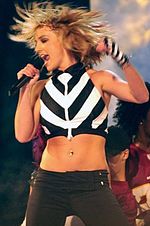 Singer Britney Spears was one of the best selling female performers of the 2000s.
Singer Britney Spears was one of the best selling female performers of the 2000s.
Teen Pop continued to be an extremely popular genre in the early 2000s with success of teenage pop-singers Britney Spears and Christina Aguilera. Britney's "Oops!...I Did It Again" and Christina's "Come On Over Baby (All I Want Is You)" become huge hits in the year 2000. By 2001, however, the teen-pop trend dissolved dramatically due to modern R&B and hip-hop influenced music that later dominated throughout the middle of the decade. Britney Spears's 2001 album Britney and Christina Aguilera's 2002 album Stripped are examples of teen pop artists transitioning from teen pop to more grown-up, modern R&B influenced records.
Boy bands continued their popularity during the beginning of the decade but their popularity also faded after 9/11, with the exception of Backstreet Boys, as they continued with popularity through the remainder of the decade and the 2010s, and achieved record sales close to 200 million including over 120 million albums, including strong sales of their 2001 release, Black & Blue. Many fans of the boy band era collect their albums for nostalgia still giving revenue to these artists. By 2002, records by boy bands were very sparse on the Billboard Hot 100. Some members of boy bands went on to have successful solo careers, such as Jesse McCartney from Dream Street and Justin Timberlake from 'N Sync. A new strain of boy bands, such as V Factory, Varsity Fanclub, Click Five, NLT, and the Jonas Brothers, took place at the end of the decade, but the boy band trend did not become as glamorized as it was at the beginning of the decade, with the exception of the Jonas Brothers. Girl groups kept their popularity through the 2000s, with groups such as Destiny's Child, Pussycat Dolls,
After 9/11, a new "teen pop-rock" movement began. While girl pop-rock singers such as Alanis Morissette and Jewel were popular in the 1990s, they had declined in popularity after 1998 when the pop princesses such as Britney Spears debuted. Avril Lavigne was arguably the first and lead artist to take this new direction in pop music, with hits such as "Complicated", "Sk8er Boi", "I'm with You" at the beginning of the decade and "Girlfriend" at the end, Lavigne leads this genre throughout all the decade worldwide, with her contemporaries, such stars as Michelle Branch and Vanessa Carlton, not far behind with their own success. Other prominent girl pop-rock artists of the 2000s included Pink, Hilary Duff, and Ashlee Simpson. Later artists reflecting the genre include Selena Gomez & the Scene, Demi Lovato, Miley Cyrus, Katy Perry and Taylor Swift.
In 2001, triple-threat entertainer Jennifer Lopez debuted at number one on the U.S. Billboard 200 and the Top R&B/Hip-Hop Albums chart with her J.Lo album and in addition her film, The Wedding Planner, opened at number one at the box office at the same time making her the first actress and singer in history to have both a film and an album at number one in the same week.
Artists such as Janet Jackson, Kylie Minogue, Madonna and Nelly Furtado experienced revived success. Justin Timberlake shot to stardom with his Justified album. In 2005, Cher ended her 3-year long "Farewell Tour" which became the highest grossing female and solo tour at that time.
American Idol winners became a big part of the American pop sound, but only one winner became a staple. Season 1 winner Kelly Clarkson experienced huge success and tons of hit radio singles with her pop-rock sound including worldwide hits "Breakaway", "Since U Been Gone", "Behind These Hazel Eyes", and "Because of You" at the middle of the decade.
Lady Gaga took the later part of the decade by storm and revived the electronic influence of pop music that was not prominent since 2000. Her debut album, The Fame, was released on August 19, 2008. It reached number-one in Canada, Austria, Germany, United Kingdom and Ireland and topped the Billboard Top Electronic Albums chart. Its first two singles, "Just Dance" and "Poker Face", became international number-one hits, topping the Hot 100 in the United States as well as other countries. The album later earned a total of six Grammy Award nominations and won awards for Best Electronic/Dance Album and Best Dance Recording. By the fourth quarter of 2009 she had released her second studio album The Fame Monster, with the global chart-topping lead single "Bad Romance".
Internet personalities (people who were primarily famous as a result of the Internet) such as Justin Bieber and Soulja Boy Tell Em enjoyed success in the pop charts. During the 2000s many different internet personalities were discovered by fans on the internet, and as a result were signed and gained much success in the charts. This continues into the 2010s.
 American Idol winner Kelly Clarkson makes huge hits in pop music charts and over 20 million records, best-selling Idol.
American Idol winner Kelly Clarkson makes huge hits in pop music charts and over 20 million records, best-selling Idol.
In 2001 Michael Jackson, one of popular music's most successful artists of all-times, released his final studio album Invincible before his death, though it did not receive a lot of exposure. Michael Jackson died in June 2009, creating the largest public mourning since the death of Diana, Princess of Wales in 1997.[31][32][33]
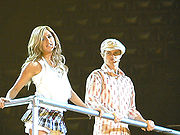 Ashley Tisdale and Lucas Grabeel members of the High School Musical, the Disney's musical and soundtracks most successful of the 2000s.
Ashley Tisdale and Lucas Grabeel members of the High School Musical, the Disney's musical and soundtracks most successful of the 2000s.
Children's music rises significantly in sales, especially with Disney (The Cheetah Girls, High School Musical, Hannah Montana: The Movie, and The Jonas Brothers among others). All The Cheetah Girls, High School Musical and Hannah Montana albums were among the best-sellers of 2006 and 2007 and reached the number 1 position, left many artists produced by Disney in the 2000s, The Cheetah Girls, Hilary Duff, Selena Gomez & the Scene, Miley Cyrus, Jonas Brothers, Raven-Symoné, the best-selling artists of the decade.
The musical style of the 1980s influenced pop music to some extent in the later stages of the decade, especially around late 2009, as seen in Rihanna's hit "S.O.S." (a sampling of Soft Cell's "Tainted Love"), "She's Like The Wind" by "Lumidee" and Flo Rida's "Right Round", a reworking of the Dead or Alive hit "You Spin Me Right Round". Other hits include Aaron Carter's cover of Bow Wow Wow's "I Want Candy", and Britney Spears' covers of "My Prerogative" and "I Love Rock 'n' Roll". Pop rock groups such as Metro Station and Owl City also displayed 80s influences. Beyoncé's hit "Sweet Dreams" was not a direct sampling of an 80s pop hit but Anne Hagerty of Billboard magazine was quoted saying, "this track will fit right on a Michael Jackson or Madonna instrumental." Alien Ant Farm successfully covered Michael Jackson's "Smooth Criminal", and Fall Out Boy came out with their own cover of "Beat It", later on. Bowling for Soup also had a hit with "1985", a nostalgic ode to 1980s.
The 1980s female popstar, Cyndi Lauper, released several albums with different styles, like adult contemporary, pop, pop rock, electronic music and blues, that were critically acclaimed and received several nominations for Grammy Award and had sales significant throughout the decade.
Adult contemporary
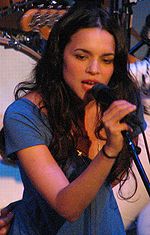 Norah Jones, 29 May 2007
Norah Jones, 29 May 2007
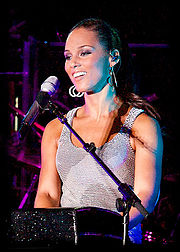 Alicia Keys was the R&B artirst best selling female performer of 2000s.
Alicia Keys was the R&B artirst best selling female performer of 2000s.
Adult contemporary music (also known as "soft rock" or "lite-rock"), began to somewhat decrease in popularity starting in the late '90s (due to the increasing popularity of Top 40 music) into January 2000 until September 11th, 2001. After 9/11, popularity for Adult Contemporary Music (as well as Contemporary Christian Music crossovers) increased tri-fold during the grieving process, when the 25-44 Conservative Female Demographic favored listening to songs with appropriate, positive and uplifting lyrics containing love and hope. Upon the eventual return back to normalcy after 9/11, the popularity of Adult Contemporary music held steady until about 2003, when Billboard began to change their chart formats. This led to Adult Contemporary stations to program their music "not-as-soft" or "cheesy" as they used to, and ended up substituting the words "soft-rock" with "lite-rock", which has a more modern-edged connotation. Yet, AC stations remained careful to not cross the Adult Top 40 format line. Because of all these changes, AC Stations slowly increased in popularity.[citation needed]
In the late 2000s, artists like Coldplay, Daughtry and Gavin Rossdale were finding more success crossing over onto the Adult Contemporary charts.
On the female side, artists like Sara Bareilles, Colbie Caillat, Diana Krall, Norah Jones, Kelly Clarkson, Alicia Keys, and Leona Lewis continued to find crossover success on the Adult Contemporary charts as well. AC veterans such as Celine Dion, Rod Stewart, Phil Collins, The Eagles, Cyndi Lauper, Alanis Morissette and Sheryl Crow continued to release music only on the Adult Contemporary formats. There are three songs which experienced longevity atop the chart, "Love Song" by Sara Bareilles, "Bubbly" by Colbie Caillat, and "Breakaway" from Kelly Clarkson spent a longevity 20 weeks atop the chart.
Alicia Keys is considered the most successful R&B singer of the decade with 30 million records sold worldwide. Keys scored hits in the U.S. charts with seven songs on the Hot R&B/Hip-Hop Songs and four songs on the Billboard 100. She shares a record with Britney Spears, being the only two female singers to have their first four albums debuting in first place in the chart Billboard Hot 200.
Norah Jones is considered[who?] the greatest Jazz singer of the decade with 37 million records worldwide. She broke worldwide in 2003, a year after releasing her debut album Come Away With Me with 10 million copies sold in United States of America and 20 million sold worldwide. Jones continued her success with her second album becoming the biggest selling album in one week with 1,900,000 million copies sold, going on to release two more bestselling albums in the 2000s, and having 3 albums debut in the Billboard 200 and winning eight Grammys with her debut album and 12 Grammys in total during the decade.
Contemporary R&B
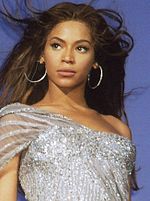 Beyoncé Knowles was the best selling female performer of 2000s.
Beyoncé Knowles was the best selling female performer of 2000s.
 Rihanna was one of the best selling female performers of 2000s.
Rihanna was one of the best selling female performers of 2000s.
The continued popularity of contemporary R&B was seen during this decade in the global success of established artists such as Beyoncé, Mariah Carey, Jennifer Lopez and Usher, whose careers began in the 1990s and continued in the dawn of the new millennium. The year 2001, in particular its summer, has been described as a golden age for contemporary R&B and urban soul music, with artists such as Jill Scott, Mariah Carey and Destiny's Child, who paved the way for Alicia Keys, Blu Cantrell, and the revival of Aaliyah.[34][35]
At the 2011 Billboard Music Awards, Beyoncé Knowles was honored with the Billboard Millennium Award for recognizing her career achievements and influence in the music industry.[36] She was ranked the 4th Artist of the 2000s decade by Billboard,[37] and was listed the most successful female artist of the 2000s, as well as the top radio artist of the 2000s.[38] The Recording Industry Association of America (RIAA), also recognized Knowles as the top certified artist of the 2000s.[39][40] As of May 2010, Knowles has sold more than 11.2 million albums and 25 million singles in the United States. As of September 2009, she has sold 75 million records worldwide as a solo artist, making her one of the best-selling music artists of all time.[41]
Jennifer Lopez 2000s R&B singer. Selling over 55 million records worldwide album.
Beyoncé Knowles, Michelle Williams and Kelly Rowland, better known as Destiny's Child is the most successful female R&B group of all time, selling over 50 million records worldwide during the 2000s. The group has many chart topping singles worldwide, such as "Survivor", "Say My Name" "Bootylicious", "Independent Women Part 1" and "Jumpin'Jumpin'".
Other emerging acts from the early 2000s include Ashanti, Rihanna and Ciara.[42]
R&B artist Robin Thicke Topped the R&B Charts with his hit single "Lost Without U". He was the first white artists to top these charts since George Michael. His album "The Evolution of Robin Thicke" went on to be certified platinum by the RIAA.
Musical Artist Usher released the album "Confessions" which went on to become the best-selling album of 2004 and the second best-selling album of the 2000s. Confessions is now certified Diamond by the RIAA.
Country
Country slipped in mainstream popularity in the early 2000s, due partly to the public retirement of Garth Brooks, the election of George W. Bush, the conservative patriotic aftereffects of the September 11 attacks as seen in Toby Keith's In Courtesy of the Red, White, and Blue and partly due to a growing discontent among some traditional country music fans and artists over the perceived direction and sound of the genre. But, the upper part of the Billboard 200 all-genre album chart frequently had albums recorded by country music artists listed; several of those titles were certified double platinum or better, indicating the genre continued to have a strong niche in the music industry.
One of the most successful new artists of the decade was Carrie Underwood. In 2005, the Checotah, Oklahoma, native became the first American Idol winner to record primarily country music, instead of pop, rap or rhythm and blues. Although several of her songs did enjoy crossover popularity, Underwood had amassed eight No. 1 songs on the Billboard Hot Country Songs chart by the end of the decade, along with numerous awards from the Country Music Association, Academy of Country Music and others.
Country pop, a subgenre which has its roots in the Nashville Sound of the late 1950s-early 1960s, continued to flourish in popularity. The most prominent act was Shania Twain, with her album Up!, released in 2002, Other top performers in the genre included Dixie Chicks, Lonestar, Martina McBride, Tim McGraw, Faith Hill, Keith Urban and Rascal Flatts. In the middle of the decade, an informal group of singers and songwriters called the MuzikMafia formed to promote their mesh of honky-tonk and outlaw brand of country music; the most prominent members were "Big" Kenny Alphin and John Rich (of the duo Big & Rich) and Gretchen Wilson, who enjoyed success in the middle part of the decade.
Many non-country artists enjoyed success in the country music during the 2000s. The most successful of these artists has been former Hootie & the Blowfish lead singer Darius Rucker, who had three No. 1 hits in 2008–2009: "Don't Think I Don't Think About It", "It Won't Be Like This for Long" and "Alright." The Eagles, a California-based country-rock group, had their first major success on the Hot Country Songs chart in more than 30 years in 2007–2008 with the songs "How Long" and "Busy Being Fabulous." Other non-country artists who had success in the genre were Kid Rock, Sheryl Crow, Robert Plant, Jewel, Jessica Simpson, Bon Jovi and Miley Cyrus.
In the late 2000s, teenager Taylor Swift became the first country artist to enjoy widespread mainstream popularity since the 1980s, when artists including Dolly Parton, Eddie Rabbitt and Kenny Rogers regularly recorded music that appealed to both country and pop audiences. Two of Swift's songs — "Love Story" and "You Belong With Me" — both reached the top 5 of the Billboard Hot 100 (and No. 1 on several of the Hot 100's component charts) after topping the Hot Country Songs chart. At the 2009 MTV Video Music Awards, Swift became the first country artist to win a VMA award when she won in the Female Best Video category for "You Belong With Me".
Not everyone celebrated the success of artists such as Underwood and Swift, reflecting the continued discontent and debate over what constituted "real" country music, a debate that had been on and off since the 1970s. Despite the fact that country music songs had long been crossing over to pop radio (and charting since the start of the Billboard charts in 1940), some critics contended that the pop-oriented sound was little more than repackaged pop music. In 2009, legendary country music artist George Jones proclaimed that "they've (the new artists) stolen our identity. ... They had to use something that was established already, and that's traditional country music. So what they need to do really, I think, is find their own title, because they’re definitely not traditional country music."[43] In addition, several forums, including the classic country-oriented Pure Country Music Web site, regularly included posts that were openly critical of artists such as Swift and Rascal Flatts.[44] Songs such as "Murder on Music Row" (by George Strait and Alan Jackson) and "Too Country" (by Brad Paisley) gained widespread acceptance and radio airplay, despite criticism in the lyrics over the eschewing of traditional sounds by radio programmers.
However, traditional country music retained a large following during the decade, thanks to the ongoing successes of veteran artists such as Strait, Jackson, Reba McEntire, Brooks & Dunn, Toby Keith and Kenny Chesney, and newer artists such as Paisley, Blake Shelton and Billy Currington. Rogers, Parton and Willie Nelson, all artists who had No. 1 country hits as far back as the early 1970s, all had No. 1 songs during the 2000s decade — either as soloists (Rogers), as part of one-time duo pairings (Nelson) or as featured background vocalists (Parton). McEntire's success came with two albums hitting No. 1 on the all-genre Billboard 200 albums chart (Reba Duets and Keep On Loving You ), and at the end of the decade had her biggest hit of her career ("Consider Me Gone"). In addition, veteran songwriters such as Bill Anderson and Bobby Braddock also enjoyed continued success with newly written songs. Late in the decade, newcomers such as Jamey Johnson and Miranda Lambert were widely hailed for their songwriting and performance talents.
The legendary group Alabama retired from touring in 2004 after nearly a quarter century of mainstream success, primarily during the 1980s and 1990s. Its band members — cousins Randy Owen, Teddy Gentry and Jeff Cook; and drummer Mark Herndon — remained active performers and recorded a successful series of albums containing gospel and traditional old-time songs.
Many legendary country music figures died during the decade. Some of the more prominent names included Waylon Jennings, June Carter Cash, Johnny Cash, Buck Owens, Hank Thompson, Porter Wagoner and Eddy Arnold.
Electronic music
In Europe, Trance was popular in the early part of the 2000s but this style diminished towards the mid 2000s. Hard House became the next big craze after trance in 2001, with a certain amount of cross-over between the two genres (in some cases creating Hard Trance tracks). As a kind of backlash, ambient, Chillout music achieved mainstream popularity in the early 2000s, with a successful market of chillout compilations and the genre even making it into television commercials and soundtracks.
Disco House and Funky House, popular in the late 1990s, continued to be successful through to the mid-2000s, before the sound of Electro House developed around 2006. The electro sound began to merge with other genres such as Hip Hop as the decade drew to a close.
In 2007 and later, dance music started gaining popularity in North America with dance-pop hits by artists such as the pop singer Rihanna's song "Don't Stop the Music" and "Disturbia". Hilary Duff in her album Dignity has changed her style from pop rock to the more contemporary electropop, to go with the current trends. In 2008 and 2009 electro-pop and Nu-disco make an increase in popularity in North America and replaced hip-hop and R&B as the dominant genres of music with artists such as Britney Spears, Beyoncé, and Lady Gaga bringing this style to great popularity towards the end of the decade. The first traces of electropop has taken place in late 2006 with artists such as hellogoodbye and Timbaland. Furthermore, Madonna's singles such as "Hung Up" (#1 in 45 countries) and "4 Minutes" (#1 in 32 countries) become huge dance hits. (See hip hop, urban pop and R&B above for more information.) Pop duo Aly & A.J. explored electropop in their second album "Insomniatic". In addition, some of the most successful Electronica American artists and DJs in the 1990s, such as Moby and The Crystal Method, also continued their success during the 2000s.
Also, in the late 2000s a new era emerged that embodied rave music called Dubstep. Dubstep is characterized by a tempo between 130 and 145 BPM, heavy sub-bass, and a distinct "wobbly" bass line. It often has a "dark" sound and features more heavy sampling than previous electronic styles, as most of its young producers have grown up during hip hop's mainstream hey-day. While a very new genre, it is particularly popular in Southern California, South Florida, and Northeastern Ohio.
Jazz
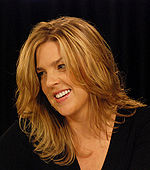 Diana Krall, 2007
Diana Krall, 2007
In the 2000s, straight-ahead jazz continued to appeal to a core group of listeners. Well-established jazz musicians, such as Dave Brubeck, Wynton Marsalis, Sonny Rollins, Wayne Shorter and Jessica Williams, continue to perform and record. In the 2000s, a number of young musicians emerged, including the pianist Jason Moran, vibraphonist Stefon Harris, trumpeter Roy Hargrove, and bassist Christian McBride.
In addition, a number of new vocalists have achieved popularity with a mix of traditional jazz and pop/rock forms, such as Diana Krall, Norah Jones, Cassandra Wilson, Kurt Elling, and Jamie Cullum. Norah Jones and Diana Krall, due to her massive international success during the 2000s it is considered the first and second most successful female jazz singer of the decade, respectively.
Reggae
- Dancehall
The early 2000s saw the success of newer charting acts such as Elephant Man and Sean Paul, who has achieved mainstream success in the US and has produced several top 10 Billboard hits, including "Gimme the Light", "We Be Burnin'", "Give It Up To Me", and "Break It Off" (a duet with Rihanna). He has also had several #1 singles, "Get Busy", "Temperature" and "Baby Boy" (a duet with Beyoncé).
- Reggaeton
Reggaeton gained mainstream exposure and massive popularity in North America during the mid-2000s. Reggaeton blends West-Indian music influences of reggae and dancehall with those of Latin America, such as bomba, plena, salsa, merengue, latin pop, cumbia and bachata as well as that of hip hop, contemporary R&B, and electronica. The influence of this genre has spread to the wider Latino communities in the United States, as well as the Latin American audience.
Billboard Artist of the Decade
On December 11, 2009, Billboard Magazine named Rapper Eminem as the best Artist of the Decade for the 2000s. He joins the list with Elvis Presley, The Beatles, Elton John, Michael Jackson, and Mariah Carey, who have also been awarded with this prestigious honor in their respective decades.
The U.K and Europe
See also: Music of the United Kingdom (2000s)Rock
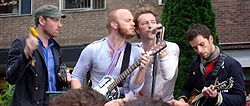 Coldplay is considered to be the most commercially successful British rock act of the decade.
Coldplay is considered to be the most commercially successful British rock act of the decade.
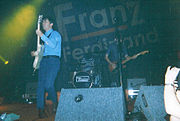 Franz Ferdinand in concert in 2004
Franz Ferdinand in concert in 2004
 Dido was one of the most successful British pop acts of the decade.
Dido was one of the most successful British pop acts of the decade.
Post-Britpop acts such as Keane followed after the success of Radiohead and The Verve to the top of the album charts during the decade. British Indie rock and indie pop returns to popularity in the mid-late 2000s with artists such as Arctic Monkeys, Franz Ferdinand, Amy Winehouse, Kaiser Chiefs, The Libertines, Editors, Lily Allen, Kate Nash, Florence And The Machine, and The Ting Tings achieving great chart success. Post punk bands such as Bloc Party, Foals and Editors become popular. Oasis also remained popular spawning four number one albums in the UK until the bands disbandment in autumn 2009. Sleepy Hollow brought back the "retro" sound with their first release in 2000.
U2 continued their popularity into the 2000s with three albums which were all critical successes, and have been credited with influencing many newer bands such as Radiohead and Muse.
In the early and mid 2000s garage rock sees a revival. British Indie Rock bands like The Libertines, Arctic Monkeys, Bloc Party, also saw success. Indie music itself becomes popular due to the increased commercialization of alternative, and major labels begin marketing indie bands with mainstream appeal.
Radiohead also enjoyed further success in the 2000s, moving away from their experimental sound of the Kid A/Amnesiac era, to a more "typical" Alternative Rock sound. Muse also enjoyed success, with the rock trio releasing three number 1 albums between 2003 and 2009, drawing influences from a variety of bands, such as Rage Against the Machine, Queen and Jeff Buckley, as well as classical composers
The 2000s entering into the early 2010s also saw the revival and influence of synthpop music. This revival is sometimes known as new urban pop. Also popular in the U.S., artists such as Hot Chip, Junior Boys, Little Boots and La Roux.
The era also saw solo success for singer/songwriters, including David Gray, Dido,[45] James Blunt, James Morrison,[46] KT Tunstall and Amy Macdonald.[47]
Hip hop
 Live concert of the Gorillaz, April 2010
Live concert of the Gorillaz, April 2010
The eponymous debut album of Gorillaz, created by Damon Albarn in 2001, sold over seven million copies and earned them an entry in the Guinness Book of World Records as the Most Successful Virtual Band.[48]
Grime, a distinctly British version of hip hop, became popular, with notable artists such as Dizzee Rascal and Tinchy Stryder achieving success.[49]
Pop
When American vocal group Backstreet Boys returned to the music scene in 2005 with a more adult rock sound, it saw some past boy bands follow. Take That reunited in 2006 without Robbie Williams and recreated their earlier success. Bands such as Boyzone also find success, whilst others such as 5ive and East 17 fail and once again disband. The Irish boy band Westlife were very successful and emerged as the top selling British band of the decade with 44 million records sold and with record-breaking hit singles and albums.
Girl groups Sugababes, Girls Aloud and t.A.T.u. span successful careers throughout most of the decade. The Spice Girls announced an end in 2001 but later came back for a brand new tour in 2007. S Club 7 was formed in 1999 and broke up in 2003, after 5 years of costant work in the industry became one of the most famous pop groups of the country with 4 albums, 6 TV-Series, and one movie to their credit.
Irish singer Enya continued to enjoy steady success during the 2000s; her 2000 album A Day Without Rain sold 15 million copies[50] and she was named the world's best selling female artist of 2001.[51]
Reality talent shows which gave people the opportunity of a singing career became very popular with UK TV audiences. Shows included Popstars, Pop Idol, Fame Academy and The X Factor. Eurovision Song Contest is very important for the European Music. From this contest, the most famous singer for 2000s is Helena Paparizou from Greece. Helena has spawned a lot of successful singles in Europe such as "My Number One", "Mambo!", "Gigolo", "Heroes", "Teardrops", "The Light In Our Soul" etc. 1980s female pop stars Madonna and Kylie Minogue both have a big presence on the European music scene both having numerous hits in the 2000s which include for Madonna "Hung Up", "Celebration", "Sorry", Hollywood", "4 Minutes" and "Music" and for Kylie "Spinning Around", "On a Night Like This", "Can't Get You Out of My Head", "Slow" and "In My Arms". Madonna and Minogue today remains the most played female artist in UK radio history. Britney Spears became a huge impact throughout the continent and was of the most successful artist of the decade in that region.
In 2004 The Moldovan pop music trio hit song "Dragostea din tei" became a major European hit and was featured prominently in many other countries during that time as well.
Soul
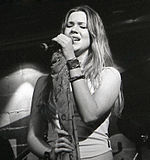 Joss Stone became one of the biggest British soul artists of the decade.
Joss Stone became one of the biggest British soul artists of the decade.
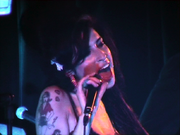 Amy Winehouse became one of the biggest British soul artists of the decade.
Amy Winehouse became one of the biggest British soul artists of the decade.
British soul in the 2000s was dominated by female singers, many of them white, Joss Stone, was the singer that began with the British soul invasion, after it emerged, Natasha Bedingfield, Corinne Bailey Rae, Amy Winehouse,[52] Adele and Duffy, all of whom have enjoyed success in the American charts, leading to talk of a "Third British Invasion", "Female Invasion" or "British soul invasion".[53]
Electronic music
 The French electronic music duo Daft Punk became one of the biggest European Electronic music acts of the decade.
The French electronic music duo Daft Punk became one of the biggest European Electronic music acts of the decade.
The popularity of the Eurodance genre in the 1990s eventually leads to the huge popularity of the trance genre in the late 1990s and early 2000s. Popular artists of the decade include ATB, Ian Van Dahl, Dj Sammy, Alice Deejay, Fragma, Robert Miles, Tiësto, Armin Van Buuren, Paul Oakenfold, Paul Van Dyk and Darude.
Popular Euro house artists of the decade include: Fatboy Slim, The Chemical Brothers, Groove Armada, Basement Jaxx, Daft Punk, Massive Attack, Röyksopp, Orbital, Propellerheads, Underworld and David Guetta.
Electro, as well as music that combines it with House becomes mainstream in the dance music scene in the middle of the decade, replacing the mainstream of more jazzy and Latin influenced sounds from the beginning of the decade. Electro House artists such as Justice and MSTRKRFT gain popularity in clubs around the world, and also in Live PA's, where they remix their music for a live crowd. Dubstep and Bassline House achieve more mainstream success within the dance music scene, with artists like Skream and T2 becoming well known. Dance and eurodance singers and bands such as Kate Ryan, September, Alcazar, Basshunter, and Cascada become popular around the world.
Australia and New Zealand
Pop
 Kylie Minogue is considered the biggest Australian pop act of the decade.
Kylie Minogue is considered the biggest Australian pop act of the decade.
The most successful Australian female artist, Kylie Minogue still has a presence on the Australian music scene with her recent album X charting at number one along with its lead single 2 Hearts becoming her 10th Australian number 1 single.
Ex-Neighbours star, Delta Goodrem released her debut album Innocent Eyes in 2003 which became a monster smash hit - it went to #1 and stayed for 29 non-consecutive weeks, being certified 14x Platinum for selling over one million copies, the second most of all time in Australia.
In New Zealand, pop singer Brooke Fraser has seen large success throughout her music career with number one songs and countless New Zealand Music Awards wins. Other popular artists include, Aaradhna, Vince Harder, Anika Moa, Gin Wigmore, whose debut album Holy Smoke peaked at number one in New Zealand in 2009 and Ladyhawke (musician), who achieved substantial international success following the release of her self-titled debut album in 2008, which peaked at number one in New Zealand and charted in the top twenty in Australia and the United Kingdom. In 2009 she received several New Zealand Music Awards and ARIA music awards and was nominated for a BRIT award in 2010.
Rock
Many new rock and alternative groups/bands form during the early years of this decade. Groups/bands such as The Vines and Jet become very popular amongst others around 2002–2003, paving the way for a mass of new groups midway through the decade such as Wolfmother. Other popular artists include Powderfinger, The Vines, You Am I, Silverchair, AC/DC, The Living End, Spiderbait, Grinspoon, Kisschasy and Eskimo Joe.
Many rock artists in New Zealand were popular throughout the 2000s decade including, Evermore, The Feelers, Neil Finn, Tim Finn, and Liam Finn.
Alternative
From 2003 up until 2007 a popular American television show, The O.C., popularized many New Zealand alternative rock bands by playing their music during the years of the series run. These bands included, Evermore and Youth Group.
R&B
Throughout the 2000s decade New Zealand R&B and Soul music had become more popular. Artists such as Hollie Smith whos music featured on the soundtrack for the film No. 2 (film) had large success with the single Bathe in the River. The genre has seen rapid growth with the rise of R&B/Soul singers such as, J.Williams (singer), idol winner Stan Walker and especially idol runner-up Jessica Mauboy.
Hip Hop
Early into this decade, Australian Hip Hop have proved ultimate success through an Adelaide Hip-Hop trio, Hilltop Hoods. They became the first successful Australian Hip Hop outfit, followed by a Sydney Hip-Hop trio, Bliss n Eso. Each have achieved ARIA awards.
The New Zealand hip hop scene have seen the success of artists such as, Scribe, Savage, Smashproof, David Dallas, Young Sid, Nesian Mystik and P Money. In 2009 Smashproof and Gin Wigmore collaborated on the successful single Brother, which stayed at number one on the New Zealand charts for eleven weeks, breaking the 23-year-old record for longest consecutive run at number one on the charts by a local artist. The single also charted in Germany.
Latin America
 Shakira is considered the biggest Latin act of the decade.
Shakira is considered the biggest Latin act of the decade.
Pop
The Colombian Latin pop singer Shakira breakthrough at the early 2000s led to her major international success in many non-Spanish-speaking countries, especially the United States in addition to the music scene of Latin America. In 2001, and aided by heavy rotation of the music video, "Whenever, Wherever", she broke through into the English-speaking world with the release of Laundry Service, which sold over 13 million copies worldwide.[54][55] Four years later, Shakira released two album projects called Fijación Oral Vol. 1 and Oral Fixation Vol. 2. Both reinforced her success, particularly with one of the most successful song in the 21st century to date, "Hips Don't Lie" which sold over 10 million copies and downloads worldwide and hit number 1 in many countries.[56] From October–November 2009 Shakira released her latest album She Wolf worldwide.[57] Due to her massive international success during the 2000s she is considered the second most successful female Latin singer.[58]
Reggaetón
In 2002, New York-based group Aventura would reinvent bachata, thus making it a dominant Latin genre. By 2004, reggaeton would become a staple in music with acts such as Don Omar, Daddy Yankee, Pitbull, Wisin & Yandel and Calle 13 in Alternative-reggaeton leading the way. By mid 2000s Reggaetón had replaced salsa, merengue and cumbia as the main dance genre in nightclubs for young people all over Latin America, reaching popularity in parts of Spain and Italy as well.
Salsa and merengue
Although salsa and merengue began to decline in popularity, merengue would have new life injected thanks to the subgenre known as, "merengue de calle" (or street merengue). Beginning in 2004, this subgenre combining elements of merengue, rap, and reggaeton would be popularized by Dominican acts such as Omega, Silvio Mora, El Sujeto, and Tito Swing.
Pop rock begins to take shape in Latin music with acts such as Camila, Kany García, Jesse & Joy, Belinda Peregrin and Ha*Ash. Also, more established pop acts such as Pepe Aguilar, Alejandro Fernández, Luis Fonsi, and ex-OV7 member Kalimba would use pop rock in their repertoires. Pop-rock music hits new highs in the 2000s with acts such as Maná, Juanes, and Julieta Venegas topping the charts in several countries.
Asia
With the rapid development of Asian economies during the 1990s and 2000s, the independent music industries of Asia have seen considerable growth. Asian countries like Japan and India have some of the largest music markets in the world. Supported by their own large markets, the music charts in Asia are largely dominated by local Asian artists, with very few artists from the Western world managing to break those markets.
J-pop and K-pop have become increasingly influenced by contemporary R&B, hip hop music and Eurobeat, and they have become popular all over the Far East region. Meanwhile in the Southern Asia region, the rising independent Indian pop scene, often characterized by its fusion of Indian and non-Indian sounds, has begun to increasingly compete with the popularity of Bollywood filmi music in the region.
Japan
See also: J-PopJ-Pop continues to be in the mainstream and stays as the most popular style of music in Japan. Japanese Pop's popularity continues to expand through Asia and the rest of the world, with various Japanese artists debuting in the US. J-Pop starts to enjoy a relatively big global online fan base. It continues to influence worldwide styles of music, as Japanese culture has continuously become more popular around the world. Japan also remains as the second most powerful musical industry in the world, and the second largest music market, after the US. R&B is popular at the beginning of the era, with Hip-Hop also becoming more popular as time passes. At the end of the decade, Dance music and Techno become the most popular genres. Bubblegum pop remains popular during the entire decade.
Ayumi Hamasaki becomes one of the most popular Japanese star of the 2000s, experiencing her biggest peak at this time, becoming known as "The Empress of Japanese Pop", and greatly influencing music, fashion and pop culture. Ken Hirai becomes the most popular male solo artist. 1990s divas like Namie Amuro, Misia, and Hikaru Utada also remain extremely popular during this era, with the former having a second popularity boom in 2008. Starlet Kumi Koda also becomes insanely popular in this era, thanks to her fresh dance style and provocative dance moves. Boy bands are the most popular musical format at the moment, with girl bands like Morning Musume (very popular in the past) experiencing a decline in popularity. While Johnny's boy bands become very popular, other vocal groups like Exile and Tohoshinki also gained popularity and pop/rock bands like Mr. Children, Tokio and Glay remained popular. Duets also become popular, such as M-Flo. Like all countries, English pop music popularity expands at a very high rate with popular U.S artist receiving success such as Backstreet Boys and Britney Spears who become the most popular and two of the most successful non-Japanese artists.
India
See also: Indian pop and FilmiThe Indian music industry was previously dominated by the Filmi music of Bollywood for much of the late 20th century. The 2000s saw an increasing popularity of independent Indian pop music that could compete with Bollywood film music. Indian pop music began distinguishing itself from mainstream Bollywood music with its fusion of Indian and non-Indian sounds, which later had on influence on Bollywood music itself. Indian pop has itself been partly influenced by the Asian Underground scene emerging in the United Kingdom among British Asian artists such as Bally Sagoo, Apache Indian, Panjabi MC, Raghav and the Rishi Rich Project (featuring Rishi Rich, Jay Sean and Juggy D). India has one of the largest music markets in the world, though like other developing nations, suffers from high levels of piracy.
Indian music has also had an increasing influence on popular music in the Western world. The music of South Asia has influenced Europe's pop mainstream as acts like Björk, Bananarama, Erasure, and Siouxsie and the Banshees all released singles or remixes featuring South Asian instrumentation. Indian music has also influenced mainstream American hip hop, R&B and urban music in the 2000s, including artists/producers such as Timbaland, Jay-Z, Dr. Dre, Truth Hurts, The Black Eyed Peas, Missy Elliott and Britney Spears. According to DJ Green Lantern, "Indian beats have now become a fixture on the R&B scene".[59] Several Hollywood musical films such as Moulin Rouge! have incorporated Bollywood songs, while several Indian music composers have gained international fame, particularly A. R. Rahman who, having sold over 300 million records worldwide, is one of the best-selling music artists of all time.[60][61] M.I.A., a Sri Lankan electronic artist incorporates Bollywood songs in her music.
See also
- 2000s in the music industry
- 2000s
- 1990s in music
- 2010s in music
References
- ^ http://www.allmusic.com/explore/style/indie-electronic-d12983
- ^ [1] Archived January 24, 2007 at the Wayback Machine
- ^ "hip Hop". Britannica. 2011. http://www.britannica.com/EBchecked/topic/266545/hip-hop. Retrieved 2011-10-30.
- ^ [2][dead link]
- ^ Reynolds, Simon (2009-11-26). "Simon Reynolds's Notes on the noughties: When will hip-hop hurry up and die?". The Guardian. http://www.guardian.co.uk/music/musicblog/2009/nov/26/notes-noughties-hip-hop. Retrieved 2011-08-25.
- ^ "'Nevermind,' never again?". CNN. 2011-09-23. http://www.cnn.com/2011/09/23/showbiz/music/nirvana-nevermind/index.html. Retrieved 2011-10-27.
- ^ McCormick, Neil (2009-08-05). "La Roux, Lady Gaga, Mika, Little Boots: the 80s are back". The Daily Telegraph (London). http://www.telegraph.co.uk/culture/music/rockandpopfeatures/5978573/La-Roux-Lady-Gaga-Mika-Little-Boots-the-80s-are-back.html.
- ^ Topping, Alexandra (2011-01-11). "RIP rock'n'roll? Professor of pop reads the last rites". The Guardian. http://www.guardian.co.uk/music/2011/jan/10/rock-n-roll-read-last-rites. Retrieved 2011-11-07.
- ^ a b T. Grierson, "Post-Grunge: A History of Post-Grunge Rock", About.com. Retrieved 1 January 2010. Archived 13 February 2011 at WebCite
- ^ H. Phares, "Franz Ferdinand: Franz Ferdinand (Australia Bonus CD)", Allmusic. Retrieved 6 January 2010.
- ^ J. DeRogatis, Turn on your Mind: Four Decades of Great Psychedelic Rock (Milwaukee, Wisconsin: Hal Leonard Corporation, 2003), ISBN 978-0-634-05548-5, p. 373.
- ^ "New Wave/Post-Punk Revival" Allmusic. Retrieved 6 January 2010.
- ^ M. Roach, This Is It-: the First Biography of the Strokes (London: Omnibus Press, 2003), ISBN 978-0-7119-9601-4, p. 86.
- ^ E. J. Abbey, Garage Rock and its Roots: Musical Rebels and the Drive for Individuality (Jefferson, North Carolina: McFarland, 2006), ISBN 978-0-7864-2564-8, pp. 108-12.
- ^ P. Simpson, The Rough Guide to Cult Pop (London: Rough Guides, 2003), ISBN 978-1-84353-229-3, p. 42.
- ^ P. Buckley, The Rough Guide to Rock (London: Rough Guides, 2003), ISBN 978-1-84353-105-0, p. 1144.
- ^ B. Greenfield, and R. Reid, New York City (Lonely Planet, 4th edn., 2004), ISBN 978-1-74104-889-6, p. 33.
- ^ P. Buckley, The Rough Guide to Rock (London: Rough Guides, 3rd edn., 2003), ISBN 978-1-84353-105-0, pp. 498-9, 1040-1, 1024-6 and 1162-4.
- ^ C. Smith, 101 Albums That Changed Popular Music (Oxford: Oxford University Press, 2009), ISBN 978-0-19-537371-4, p. 240.
- ^ a b J. D'Angelo, "Will Korn, Papa Roach and Limp Bizkit evolve or die: a look at the Nu Metal meltdown", MTV. Retrieved 2 January 2010. Archived 14 February 2011 at WebCite
- ^ a b W. Lamb, "Punk Pop", About.com Guide. Retrieved 1 January 2010. Archived 13 February 2011 at WebCite
- ^ a b J. DeRogatis, "True Confessional?". October 3, 2003. Retrieved 10 April 2010. Archived 25 July 2007 at WebCite
- ^ H. A. S. Popkin, "What exactly is 'emo,' anyway?", MSNBC.com, March 26, 2006. Retrieved 10 April 2010. Archived 25 July 2007 at WebCite
- ^ a b F. McAlpine, "Misery Business", 14 June 2007, BBC.co.uk, retrieved 2 April 2009. Archived 15 February 2011 at WebCite
- ^ "My Chemical Romance’s Gerard Way Taps Another Nail Into 'Emo' Coffin", Rolling Stone, September 20, 2007, retrieved 2 May 2009.
- ^ "Panic! At The Disco declare emo 'Bullshit!' The band reject 'weak' stereotype", NME, 18 December 2006. Retrieved 10 August 2008. Archived 15 February 2011 at WebCite
- ^ http://www.google.com/trends?q=emo+music&ctab=0&geo=all&date=all&sort=0
- ^ Sanneh, Kelefa (2006-01-26). "CRITIC'S NOTEBOOK; In the Wake of Grunge, A Rock Culture Clash". New York Times. http://query.nytimes.com/gst/fullpage.html?res=9407E3DA103FF935A15752C0A9609C8B63&pagewanted=all. Retrieved 2011-11-04.
- ^ "Hot Property: Christina Aguilera's home pops back on the market". Los Angeles Times. January 18, 2010. http://latimesblogs.latimes.com/money_co/2010/01/hot-property-christina-aguileras-home-pops-back-on-the-market.html. Retrieved January 18, 2010.
- ^ "Aperadio". Christina Aguilera – Official website. http://christinaaguilera.com/press/APE_EaglesXtinaWeezer.pdf. Retrieved 2009-07-11.[dead link]
- ^ Allen, Nick. "Michael Jackson memorial service: the biggest celebrity send-off of all time". The Daily Telegraph, 7 July 2009.
- ^ Scott, Jeffry. "Jackson memorial second most-watched in TV history". The Atlanta Journal-Constitution, 8 July 2009.
- ^ Hinckley, David and Richard Huff. "Michael Jackson's memorial 2nd most-watched funeral ever, after Princess Di, say Nielsen ratings". New York Daily News, 8 July 2009.
- ^ Bogdanov, Vladimir; Chris Woodstra, Stephen Thomas Erlewine (2003), The New Blue Music: Changes in Rhythm & Blues, 1950–1999, Hal Leonard, pp. xi, 114, ISBN 978-0-87930-744-8
- ^ Erlewine, Stephen Thomas. Review: So Blu. Allmusic. Retrieved on 2009-09-19.
- ^ Ramirez, Erika (May 22, 2011). "Beyoncé Accepts Billboard Millennium Award, Delivers Show-Stopping Performance". Billboard. http://www.billboard.com/news/beyonce-accepts-billboard-millennium-award-1005186042.story#/news/beyonce-accepts-billboard-millennium-award-1005186042.story. Retrieved May 27, 2011.
- ^ "Artists Of The Decade Music Chart". Billboard. http://www.billboard.com/#/charts-decade-end/artists-of-the-decade?year=2009&begin=1&order=position. Retrieved February 8, 2011.
- ^ "Top 100 Music Hits, Top 100 Music Charts, Top 100 Songs & The Hot 100". Billboard. December 31, 2009. http://www.billboard.com/charts-decade-end/hot-100-songs?year=2009&begin=41&order=position#/charts-decade-end/radio-songs-artists?year=2009. Retrieved June 6, 2010.
- ^ Pedersen, Erik (February 17, 2010). "Beyoncé Tops Decade's RIAA Sales". The Hollywood Reporter. Lori Burgess. Retrieved 2010-02-18.
- ^ Lamy, Johnathan, Cara Duckworth and Liz Kennedy. (February 17, 2010). "RIAA Tallies the Decade's Top Gold and Platinum award Winners". Recording Industry Association of America. Retrieved 2010-02-18.
- ^ "The 50 people who matter today: 41–50". New Statesman (UK). September 24, 2009. http://www.newstatesman.com/global-issues/2009/09/world-fashion-gay-india-church. Retrieved February 7, 2011.
- ^ Gazzah, Miriam (2008), Rhythms and Rhymes of Life: music and Identification Processes of Dutch-Moroccan Youth, Amsterdam University Press, p. 98, ISBN 978-90-8964-062-8
- ^ "George Jones: New country needs new name; 'They’ve stolen our identity,' Hall of Famer says of genre's new crop of stars", Associated Press, November 2, 2009. Accessed 12-29-2009. George Jones: New country needs new name - Entertainment - Music - TODAY.com
- ^ PureCountryMusic.com Blog: Your #1 Source for Classic Country Music News and Information! Classic Country Music News and Views | PureCountryMusic.com Blog.
- ^ M. Heatley, David Gray: A Biography (Omnibus Press, 2nd edn., 2004), ISBN 978-1-84449-010-3, p. 107.
- ^ L. Brandle, "Young British talent gets fresh", Billboard, Dec 23, 2006, 118 (51), p. 40.
- ^ P. Sexton, "Mac attack: Britain's other Amy hit the States", Billboard, Aug 9, 2008, 120 (32), p. 42.
- ^ Cooper, James (2007-11-19). "Gorillaz: D-Sides". inthenews.co.uk. Archived from the original on 2010-01-17. http://www.inthenews.co.uk/entertainment/reviews/music/r-n-b-rap/gorillaz-d-sides-$1170827.htm. Retrieved 2009-02-11.
- ^ Koranteng, Juliana. "Hip-Hop Across the Pond: A Black British Invasion?". The Root. http://www.theroot.com/views/hip-hop-across-pond-black-british-invasion?GT1=38002.
- ^ About Enya » FAQ
- ^ "Enya Wins Best Selling Female At World Music Awards | Hobbit Movie News and Rumors". Theonering.net. 2002-03-08. http://www.theonering.net/torwp/2002/03/08/14783-enya-wins-best-selling-female-at-world-music-awards/. Retrieved 2009-08-14.
- ^ N. McCormick, "Flower of Brit-soul turns shrinking violet" Daily Telegraph, 29 Jan 2004, retrieved 02/07/09.
- ^ "Singer-songwriter Adele brings introspection to Brit-soul scene", Seattle Times January 26, 2009, retrieved 02/07/09
- ^ "Shakira's Biography". Shakira.com. 2008-05-14. http://www.shakira.com/biography/. Retrieved 2009-10-31.
- ^ Shakira’s songs are the heart of her success, BMI.com
- ^ "Hips Don't Lie". Bestuff. http://bestuff.com/stuff/hips-dont-lie.
- ^ Diver, Mike (2009-10-19). "Shakira She Wolf Review". BBC. http://www.bbc.co.uk/music/reviews/dq8r. Retrieved 2009-10-25.
- ^ MTV EMA 2010 :: 07.11.2010 :: Madrid :: Shakira
- ^ "Jay-Z thrilled by the Indian response to his song". Zee News. December 16, 2009. http://spicezee.zeenews.com/articles/story49030.htm. Retrieved 2009-12-16.
- ^ "Another victory for AR Rahman, Jai Ho!". Hindustan Times. October 24, 2009. http://www.hindustantimes.com/Another-victory-for-AR-Rahman-Jai-Ho/H1-Article1-468688.aspx. Retrieved 2009-11-15.
- ^ "A.R. Rahman in cross-cultural film project". Times of India. December 3, 2009. http://movies.indiatimes.com/News/AR-Rahman-in-cross-cultural-film-project/articleshow/5294822.cms. Retrieved 2009-12-14.
Categories:
Wikimedia Foundation. 2010.


